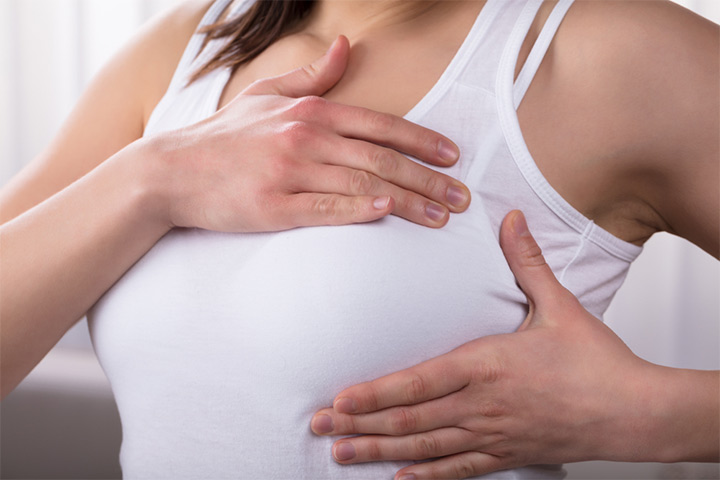When harmful bacterias get into your breast, they can cause breast infection. It typically produces inflammation on the breast skin and your body’s response to it as a breast infection.
Breast infection is associated with breastfeeding women, but it can also happen to non-breastfeeding women and men as well. In recent years, the rate of breast infection cases has increased from 10 to 33 percent among women, while about 1 percent of men may suffer.
So let’s discuss the symptoms, causes, types, diagnosis, treatment options and home remedies for breast infection.
Symptoms
The symptoms of breast infection that you may experience are:
- Fever
- Nausea
- Body aches
- Fatigue
- Breast pain
- Breast lumps
- Cracked nipples
- Red streaks around nipples
- Unhealed sores or ulcer on the breast skin
While based on breastfeeding, other symptoms are divided into:
- Lactational mastitis (breastfeeding) – Unusual breast tender, firmness, warm breast, palpable mass, pain or burning sensation while breastfeeding.
- Non-lactational mastitis (non-breastfeeding) – Reddening of the breast skin (Erythema), focal tenderness, temperature differences on the breast.
Among all the symptoms, the flu-like condition is most of the time neglected since it’s a prevalent disease. While the other symptoms are quite prominent and painful.
Causes
The most common causes of breast infection are:
- Cracked nipples – allowing harmful bacteria to enter.
- Clogged milk – developing into a subareolar abscess.
- Smoking cigarettes or tobacco – traps the anaerobic bacteria.
- Medical history – such as breast trauma, surgery, or radiotherapy.
- Medical conditions – having diabetes or rheumatoid arthritis.
- Weak immune system – unable the body to fight against bacteria.
- Breast skin infections – such as cellulitis, grow cysts on the breast.
- Immunosuppressive medications – taking steroids, transplant medications, or cancer medications.
Knowing the causes and symptoms will help your doctor diagnose the breast infection type and plan its treatment.
Types Of Breast Infection
The major types of breast infection are classified into the following types:
- Bacterial breast infection – Staphylococcus aureus, streptococcus, and anaerobic bacteria enter into the breast tissue and infect them.
- Fungal breast infection – A rash that frequently itches and has a yeasty smell.
- Idiopathic granulomatous – A painful but noncancerous mass develops in the breast.
- Tuberculosis – Hard lump situated in the breast’s central or upper outer quadrant.
Bacterial breast infection is prevalent among women during pregnancy or breastfeeding. In contrast, anaerobic bacteria are specifically reported among smoking people and can reside inside the breast without oxygen while infecting breast tissues for a longer period.
All the other three infections are much more severe but occur less frequently as compared to bacterial breast infections.
How To Diagnose Breast Infection?
The doctor may diagnose the breast infection through:
- Physical examination – Observation of the physical changes of the breast.
- Symptoms observation – May ask about the symptoms you may have been experiencing, such as fever, body aches, etc.
- Review medical history – History of breast trauma, surgery, radiotherapy, or taking immune weakening medications for other treatment purposes such as organ transplant.
- Blood test – To count the white blood cell (WBC) circulating in the body.
- Swab test – To examine the bacteria discharged from the breast.
Before going to the doctor, it is recommended to note down your symptoms to help your doctor to pinpoint the type of infection from which you are suffering. And also, it is essential to let them know about the family medical history if anyone in your family is suffering from the same disease.
Treatment
The treatment of breast infection is highly dependent on the age, infection severity, and diagnosis report. The doctor may suggest the following treatment plan:
- If you’re breastfeeding, they’ll swab the breast discharge to examine the type of bacteria growing in the breast and prescribe the medication to stop the harmful bacteria development in your breast. You may have to take a two to three weeks long course of PO or IV antibiotics.
- If you are not breastfeeding, your doctor may ask for a mammogram or biopsy of your breast tissues to diagnose the infection in your breast.
- Fungal breast infections are treated with either oral or intravenous medications. Additionally, you may have to apply antifungal cream or lotion to the affected area of your breast.
- In case of a breast abscess or cyst, the doctor will recommend draining it. While in rare cases, the doctor may suggest breast surgery to remove the damaged ducts to cure the breast infection.
It is important to note that delaying breast infection treatment may trigger breast cancer. A few of the symptoms of breast infection are very much similar to breast cancer. And also, breast cancer occurs due to the abnormal growth of cells in the breast.
So, the doctor may ask you for additional tests if the medications are not improving your condition within 48 hours.
Home Remedies
You can use various home remedies to minimise the pain and take preventive measures to avoid the discomfort of the infection.
If you are breastfeeding, then you may have to:
- Frequently breastfeed in order to drain the breast milk.
- Use a pump to ensure the proper extraction of breast milk.
- Apply warm, moist compresses to the painful areas of the breast.
- Adopt positions during breastfeeding that helps to empty the breast milk.
- Follow a certain schedule, at least feed 2 hours a day for breastfeeding your baby.
- Take rest whenever possible to recover from breastfeeding exhaustion.
- Occasionally, massage the firm areas of the breasts to prevent any fluids from clogging.
- Apply essential oils that have anti-inflammatory, antibacterial, and antifungal properties. But rinse the breast before breastfeeding, as some oil may have toxic elements that may cause harm to your baby.
Other home remedies may include:
- Wearing loose-fitting clothing and avoiding tight bras.
- Stay hydrated and take saturated fats into your daily diet.
- Increase the intake of vitamin C to improve your immune system.
- Stop smoking to avoid the development of anaerobic bacteria on the breast skin.
- Don’t use any chemical products or even soap to clean the nipple, as it has a self-cleaning ability and can lubricate on its own.
While you can take OTC pain relievers, such as acetaminophen or ibuprofen, to get relief from pain, fever, and inflammation.
Practising these measures will help to control the infection development and may be able to cure it completely. However, you must consult your doctor if the preventive measures are not working out for you.
To Sum Up
Breast infection may occur at any age. The patient must consult with the doctor if they experience the symptoms of the infection, as properly treating it and taking home remedies helps get rid of the infection quickly and without serious complications.



Recent Comments